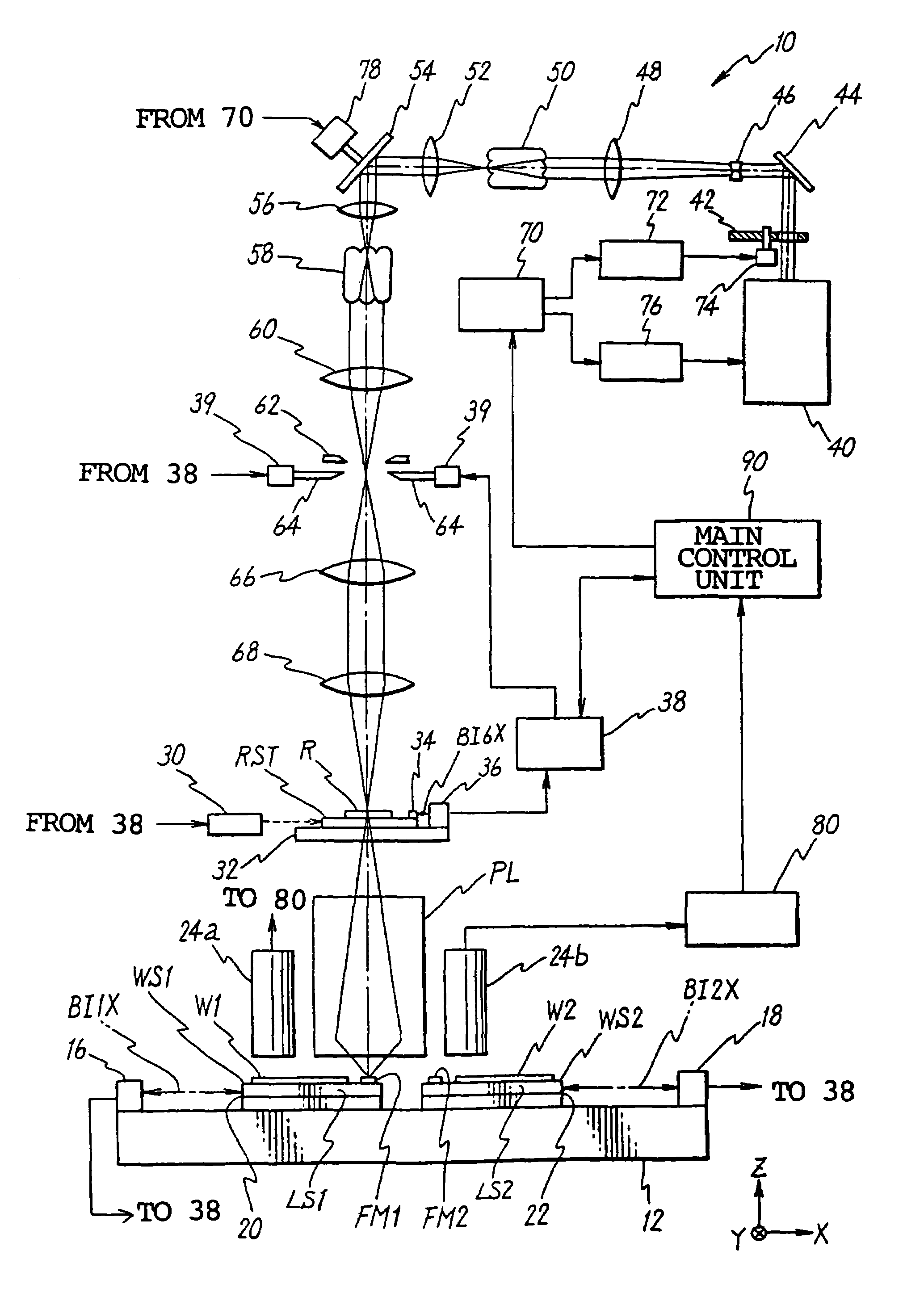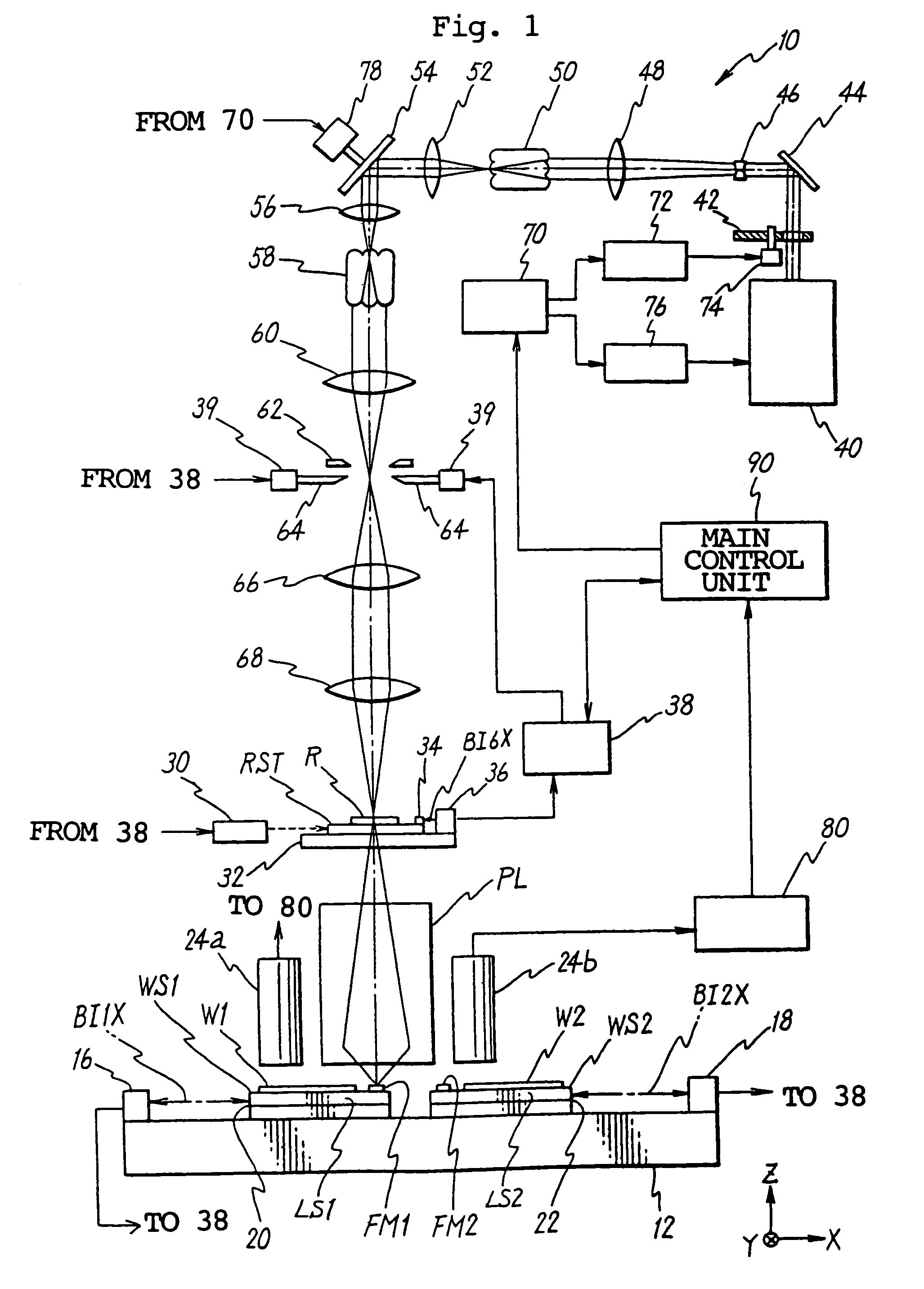Exposure apparatus and method
a technology which is applied in the field of exposure apparatus and exposure method, can solve the problems of deteriorating alignment accuracy, affecting the accuracy of alignment, and affecting the effect of accuracy, so as to achieve the effect of improving throughput and easy changing
- Summary
- Abstract
- Description
- Claims
- Application Information
AI Technical Summary
Benefits of technology
Problems solved by technology
Method used
Image
Examples
first embodiment
[First Embodiment]
[0277]A first embodiment of the present invention will be explained below with reference to FIGS. 1 to 18.
[0278]FIG. 1 shows a schematic arrangement of a projection exposure apparatus 10 according to the first embodiment. The projection exposure apparatus 10 is a projection exposure apparatus of the scanning exposure type based on the so-called step-and-scan system. A structure and a controlling method of the step-and-scan system projection exposure apparatus are disclosed in U.S. Pat. Nos. 5,646,413 and 5,448,332, the disclosures of which are herein incorporated by reference.
[0279]The projection exposure apparatus 10 comprises, for example, a stage apparatus provided with wafer stages WS1, WS2 as first and second substrate stages which are independently movable in the two-dimensional direction on a base pedestal 12 while holding wafers W1, W2 as sensitive substrates, a projection optical system PL disposed over the stage apparatus, a reticle-driving mechanism disp...
second embodiment
[Second Embodiment]
[0399]Next, the second embodiment of the present invention will be explained with reference to FIGS. 22 and 23. In this embodiment, constitutive components which are the same as or equivalent to those referred to in the first embodiment described above are designated by the same reference numerals, explanation of which is simplified or omitted.
[0400]As shown in FIG. 22, a projection exposure apparatus according to the second embodiment is characterized in that the length-measuring beam BI4Y (or BI5Y) is not deviated from the reflective surface of the stage during the movement of the wafer stage WS1 (or WS2) from the completion position of the alignment sequence to the start position of the exposure sequence, because the length of one side of the wafer stage WS1 (the length of one side of WS2 is identical thereto) is longer than the mutual distance BL between the length-measuring axes BI4Y and BI3Y (the mutual distance between the length-measuring axes BI5Y and BI3...
third embodiment
[Third Embodiment]
[0415]In the first embodiment of the present invention, the different operations are concurrently processed in parallel to one another by using the two wafer stages WS1, WS2. Therefore, there is a possibility that the operation performed on the one stage gives influence (disturbance) to the operation of the other stage. For this reason, as described above, it is necessary to adjust the timing for the operations performed on the two stages WS1, WS2.
[0416]In this embodiment, explanation will be made for the timing adjustment for the operations performed on the two stages WS1, WS2, with reference to FIGS. 11, 12 and 24.
[0417]As explained in the first embodiment, FIG. 11 shows an example of the timing of the exposure sequence for successively exposing the respective shot areas on the wafer W1 held on the stage WS1. FIG. 12 shows the timing of the alignment sequence for the wafer W2 held on the stage WS2, which is processed concurrently in parallel thereto.
[0418]As desc...
PUM
 Login to View More
Login to View More Abstract
Description
Claims
Application Information
 Login to View More
Login to View More - R&D
- Intellectual Property
- Life Sciences
- Materials
- Tech Scout
- Unparalleled Data Quality
- Higher Quality Content
- 60% Fewer Hallucinations
Browse by: Latest US Patents, China's latest patents, Technical Efficacy Thesaurus, Application Domain, Technology Topic, Popular Technical Reports.
© 2025 PatSnap. All rights reserved.Legal|Privacy policy|Modern Slavery Act Transparency Statement|Sitemap|About US| Contact US: help@patsnap.com



